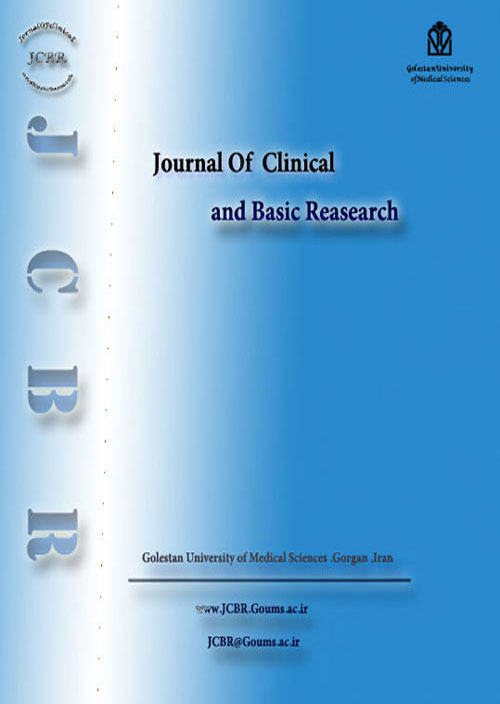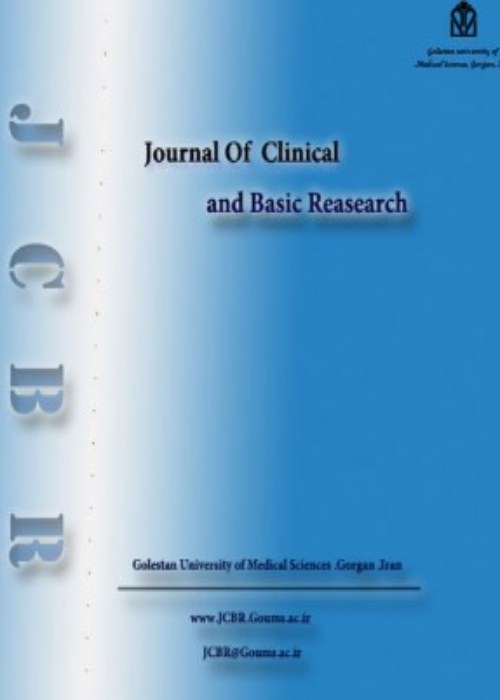فهرست مطالب

Journal of Clinical and Basic Research
Volume:6 Issue: 1, Winter 2022
- تاریخ انتشار: 1401/02/24
- تعداد عناوین: 5
-
Pages 1-10Background
There are alternative and complementary approaches for general health issues and palliative care for women with breast cancer. The current paper aimed at evaluating the effectiveness of acceptance and commitment therapy (ACT on psychological hardiness, social isolation and loneliness of women with Breast Cancer.
MethodThis was a quasi-experimental study with a pretest, posttest and 8-week follow-up with a control group. The statistical population included all women with breast cancer referred to the cancer ward of Shohada Tajrish Hospital in Tehran in 2020. 30 subjects in the study were selected through purposive sampling assigned to two groups of 15 people (experimental and control). The experimental group underwent acceptance and commitment therapy interventions for 8 sessions of 90 minutes and the control group did not receive any intervention. Data were collected using Lang and Goulet Psychological Hardiness Scale, Social Isolation Questionnaire and The UCLA Loneliness Scale and ANOVA with repeated measures was used to test the research hypotheses.
ResultsThe demographic characteristics included age (34,23 ±6,12), marriage length (8.46 ± 5,14), number of children (1–4 children) and education level (high school graduation = 10, bachelor degree = 9, MA/MS = 9, Ph.D. = 2). Based on the findings, the difference between the scores of psychological hardiness (P <0.01), social isolation (P <0.01), and the variable of loneliness (P <0.01) in the three stages of the study is significant. Also, the mean scores of all research variables in the experimental and control groups were obtained significantly (P <0.01). The results show that about 13.3%, 24.1%, and 60.7% of the individual differences in the variables of psychological hardiness, social isolation, and loneliness are related to the differences between the two groups, respectively.
ConclusionAccording to the results, it seems that acceptance and commitment therapy is effective in increasing psychological hardiness, reducing social isolation and loneliness of women with breast cancer, and the use of this treatment method on the variables was beneficial and effective.
Keywords: Acceptance, Commitment Therapy (ACT), Psychological Hardiness, Social Isolation, Loneliness, Breast Cancer -
Pages 11-27
Coronavirus disease 2019 (COVID-19) is a severe acute respiratory disease with a high prevalence. According to the research and statistical data, in January 2021, there have been 92,262,621 confirmed cases of COVID-19 and more than two million deaths. Infection with the severe acute respiratory syndrome coronavirus 2 (SARS-CoV-2) is the main cause of this disease. In addition to the respiratory system, the disease affects the gastrointestinal tract, central-peripheral nervous system, circulatory system, and kidneys. Therefore, any therapeutic action to reduce COVID-19-related symptoms and complications is essential. In this study, we conducted a systematic review of the published literature and preprints on the efficacy of erythropoietin (EPO) and recombinant human EPO as a safe stimulant and tissue protector in the treatment of COVID-19. We also briefly described the structure of coronavirus, its pathogenesis, and the structure of EPO and recombinant human EPO. All relevant articles published in the Science Direct, PubMed, and Google Scholar databases were searched. According to the results, EPO is a cytoprotective cytokine induced by hypoxia. The pleiotropic effects of EPO are associated with its erythrocyte-forming, anti-apoptotic, anti-inflammatory activities. It also exerts protective effects on the heart, lungs, kidneys, arteries, and central and peripheral nervous systems. It has been demonstrated that EPO can increase hemoglobin levels, thereby increasing oxygen delivery to the tissues. Therefore, recombinant human EPO therapy can be used for counteracting the adverse effects of COVID-19 including hypoxic myocarditis, acute renal failure, pulmonary edema, and brain-spinal cord ischemic injury. Overall, the use of EPO and recombinant human EPO therapy increases blood coagulation, tumor growth, thromboembolism, and purification of red blood cells, which must be accompanied by anticoagulants such as heparin.
Keywords: Erythropoietin, COVID-19, Hypoxia, Recombinant human erythropoietin, Pleiotropic -
Pages 28-31Background and objectives
Neural tube defects (NTDs) are common congenital anomalies caused by genetic, environmental, or nutritional factors. Normal plasma folic acid levels in the fetus are required for proper development of the neural tube. Plasma folic acid level has an inverse relationship with homocysteine level. This study aimed to determine plasma folic acid and homocysteine levels in babies born with NTDs and healthy controls.
MethodsThe study included 30 clinically diagnosed NTD cases and 30 healthy age- and sex-matched control subjects. Plasma levels of folic acid and homocysteine were measured using a direct chemiluminescence method. Data were compared using the independent t-test. Statistical analysis of data was performed using GraphPad InStat 3.0 at significance of 0.05
ResultsThe mean plasma level of folic acid in NTD cases (5.1±4.9 mol/l) was significantly lower than that in healthy controls (19.5±2.1 mol/l) (p<0.05). The mean plasma level of homocysteine in NTD cases (14.3 ± 2.4 ng/ml) was significantly higher than that in healthy controls (4.9±1.8 ng/ml)(p<0.05). The mean plasma level of folic acid was 20.1±1.5 µmol/l, 8.5 ±2.9 µmol/l, and 1.9 ±0.4 µmol/l in mild, moderate, and severe cases of NTD, respectively. The mean plasma level of homocysteine was 10.7±3.4 ng/ml, 15.4±1.2 ng/ml, and 18.5±0.8 ng/ml in mild, moderate, and severe cases of NTD, respectively.
ConclusionLow level of folic acid and high level of homocysteine are directly associated with the development of neural tube abnormalities. Moreover, the severity of the NTD is inversely related to plasma level of folic acid and directly related to plasma level of homocysteine.
Keywords: Neural tube defects, Folic acid, Homocysteine -
Pages 32-36Background
Metachromatic leukodystrophy (MLD) is an autosomal recessive neurodegenerative disease, with an estimated prevalence rate of 1 per 40,000 to 160,000 worldwide. Progressive alteration in motor and cognitive functions is the most common clinical presentation. Late infantile MLD is the most common form of the disease that presents with a progressive decrease in visual acuity, impaired swallowing, muscle rigidity, seizures, and developmental delays. We herein present a rare case of late infantile MLD in a four-and-half-year-old male patient presenting with gradually-onset paraplegia.
Case descriptionThe patient had normal growth and neurodevelopmental pattern until 15 months of age. Afterward, he had a gradually increasing abnormality in gate and finally became paralyzed since the age of three years. The patient was also suffering from dysphagia, bilateral ptosis, and bad temperament. Normal metabolic test, myopathies, and brain MRI findings led to the diagnosis of MLD with gradually-onset paraplegia.
ConclusionGenerally, early diagnosis of MLD may increase the chance of recovery from the disease. We suggest considering MLD in patients suffering from behavioral, visual, and motor regressions, especially those with normal metabolic tests.
Keywords: Lysosomal storage diseases, Metachromatic leukodystrophy, Demyelinating disease, Neurodegenerative disease, Late infantile MLD -
Pages 37-45Background
The corona virus disease 2019 (COVID-19) pandemic is one of the most important healthcare and societal challenges to have emerged in the last century. Therefore, a primary aim of this study was to evaluate the effect of acceptance and commitment therapy on depression and quality of life among women with chronic pain during COVID-19 pandemic lockdown.
Materials and MethodsIn a quasi-experimental pre-test-post-test design with a control group, 35 women with chronic pain after initial clinical evaluation and research conditions were selected and randomly divided into two groups of acceptance and commitment therapy matrix (n = 18) and control (n = 17). The experimental group received 6 sessions of weekly treatment based on acceptance and commitment by matrix method. All participants completed the Beck Depression Inventory (BDI-ΙΙ) and the World Health Organization Quality of Life Questionnaire (WHOQOL-BREF) in two stages: pretest and posttest. The collected data were evaluated utilizing SPSS V. 23. Our descriptive statistics, comprising the mean and Standard Deviation (SD), as well as empirical and statistical studies, included covariance analysis (ANCOVA) and variance uniformity Levene. (P > 0.05).
ResultsThe results showed that weekly treatment based on acceptance and commitment by matrix method had a significant effect on reducing depression (F= 1.893, P=0.151), and increasing quality of life F = 5.431; P =0.003) of women with chronic pain during COVID-19 pandemic lockdown.
ConclusionThe effectiveness of group psychotherapy based on acceptance and commitment by matrix method has a significant effect on reducing depression and increasing quality of life and reducing among women with chronic pain during COVID-19 pandemic lockdown.
Keywords: Matrix Acceptance, Commitment, Depression, Quality of Life, Chronic Pain, COVID-19 Pandemic


